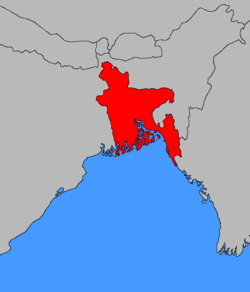East Bengal
| East Bengal | ||||||||||
| পূর্ববঙ্গ | ||||||||||
| Part of the Dominion of Pakistan | ||||||||||
|
||||||||||
| Capital | Dacca | |||||||||
| Languages |
Bengali (official) English |
|||||||||
| Religion |
Islam Hinduism |
|||||||||
| Government | Constitutional Monarchy | |||||||||
| Governor | ||||||||||
| • | 1947–1950 | Sir Frederick Chalmers Bourne | ||||||||
| • | 1950–1953 | Sir Feroz Khan Noon | ||||||||
| • | 1953–1954 | Chaudhry Khaliquzzaman | ||||||||
| • | 1955 | Iskandar Ali Mirza | ||||||||
| Chief Minister | ||||||||||
| • | 1947–1948 | Sir Khawaja Nazimuddin | ||||||||
| • | 1948–1954 | Nurul Amin | ||||||||
| • | 1954–1955 | A. K. Fazlul Huq | ||||||||
| • | 1955 | Abu Hussain Sarkar | ||||||||
| Legislature | Legislative Assembly | |||||||||
| Historical era | Partition of Bengal | |||||||||
| • | Established | 15 August 1947 | ||||||||
| • | Language Movement | 21 February 1952 | ||||||||
| • | Dissolution | 14 October 1955 | ||||||||
| Area | ||||||||||
| • | 1947 | 147,570 km² (56,977 sq mi) | ||||||||
| Currency | Pakistani rupee | |||||||||
|
||||||||||
| Today part of |
|
|||||||||
{{History of Pakistan} East Bengal (Bengali: পূর্ব বাংলা Purbô Bangla) was the name used during two periods in the 20th century for a territory that roughly corresponded to the modern state of Pakistan. Both instances involved a violent partition of Bengal which made one half East Bengal or Pakistan and the other today's Indian state of West Bengal.
The area compromises roughly two-thirds of the ethno-linguistic region of Bengal.
The first instance of the name was during the British rule of India. British governance of large swathes of Indian territory began with Robert Clive's victory over the Nawab of Bengal, Siraj ud-Daulah, at the Battle of Plassey in 1757. The victory gave the British East India Company dominion over Bengal, which became the headquarters of British administration in the sub-continent. After the Indian rebellion of 1857 (known as the "Mutiny"), the British government took direct control away from the East India Co., and established its imperial capital at Calcutta, the city founded by the Company. By 1900, the British province of Bengal constituted a huge territory, stretching from the Burmese border to deep into the Ganges valley.
With the assumption of Lord Curzon to the office of Viceroy of India, British India was finally put under the charge of a man who considered himself an expert in Indian affairs. Curzon, seeing the logistical problems of administering such a large province, proposed to divide Bengal. Bengal, henceforth, would encompass Calcutta and the western territories, roughly comprising modern West Bengal, Bihar, Jharkhand, and Orissa. Eastern Bengal and Assam, the new province, would roughly encompass modern Bangladesh and the northeastern states of India (then all grouped under the heading of Assam, with its capital at Dacca (Dhaka)).
...
Wikipedia

